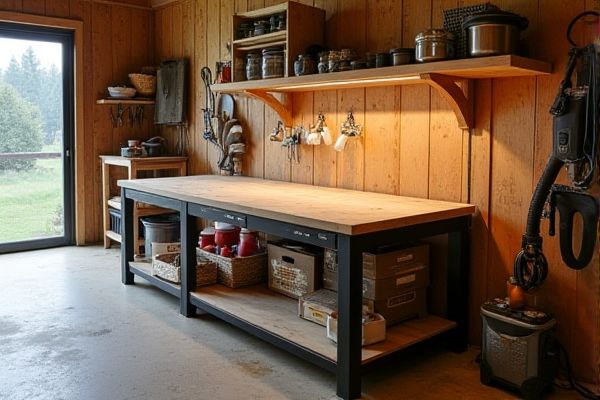
Mobile workbenches offer flexibility and easy relocation for dynamic work environments, while stationary workbenches provide stability and support for heavy-duty tasks that require a fixed position. Explore the rest of the article to determine which workbench best suits your workspace and project needs.
Table of Comparison
| Feature | Mobile Workbench | Stationary Workbench |
|---|---|---|
| Portability | High - equipped with wheels for easy movement | Low - fixed in one location |
| Size | Compact and space-saving | Larger surface area for extensive tasks |
| Weight Capacity | Moderate - suitable for light to medium work | High - designed for heavy-duty tasks |
| Stability | Less stable due to mobility features | Highly stable with fixed legs or mounting |
| Use Case | Ideal for flexible work environments and on-site jobs | Best for permanent workshop setups |
| Cost | Generally lower price point | Typically higher investment |
| Assembly | Easy to assemble and disassemble | Usually requires professional installation |
Introduction to Mobile and Stationary Workbenches
Mobile workbenches feature casters or wheels, offering flexibility and ease of movement in dynamic work environments such as automotive shops and manufacturing floors. Stationary workbenches provide a robust, fixed platform ideal for heavy-duty tasks requiring stability and precision, commonly used in woodworking and metalworking shops. Selecting between mobile and stationary workbenches depends on the specific workflow needs, space constraints, and the nature of the tasks performed.
Key Differences Between Mobile and Stationary Workbenches
Mobile workbenches provide enhanced flexibility and portability, allowing users to easily move tools and materials across different work areas, while stationary workbenches offer robust stability and support for heavy-duty tasks. Mobile units often feature lockable wheels for safe positioning, whereas stationary workbenches are designed to remain firmly anchored, accommodating larger machinery and sustained workloads. The choice between the two depends on workspace layout, task requirements, and the need for mobility versus durability.
Advantages of Mobile Workbenches
Mobile workbenches enhance workplace flexibility by enabling easy relocation across different workstations, improving workflow efficiency. They are equipped with integrated storage solutions, keeping tools organized and accessible, which minimizes downtime. Compact design combined with mobility supports space optimization in crowded workshops or job sites.
Benefits of Stationary Workbenches
Stationary workbenches offer superior stability and durability, making them ideal for heavy-duty tasks requiring precision and strength. Their fixed position allows for better organization, enhanced safety, and integration with specialized tools or machinery. These workbenches provide a solid and reliable workspace, essential for professional workshops and industrial environments.
Use Cases for Mobile Workbenches
Mobile workbenches excel in environments requiring flexibility and frequent relocation, such as maintenance, repair, and assembly tasks across multiple workstations. Their portability supports dynamic workflows in warehouses, factories, and construction sites by facilitating easy access to tools and materials on the go. Unlike stationary workbenches, mobile units enhance productivity in settings where workspace configuration or task locations frequently change.
Ideal Applications for Stationary Workbenches
Stationary workbenches are ideal for heavy-duty tasks requiring stability, such as woodworking, metal fabrication, and assembly operations that involve large or heavy materials. They provide a solid and immovable surface, ensuring precision and safety during repetitive or high-force activities. Industries like automotive repair, manufacturing, and laboratory testing often rely on stationary workbenches for their durability and consistent support.
Space and Portability Considerations
Mobile workbenches offer superior portability, allowing users to easily relocate tools and projects within a workspace, making them ideal for environments with limited space or dynamic workflows. Stationary workbenches, while less flexible, provide a stable and robust work surface suitable for heavy-duty tasks and permanent setups. Choosing between the two depends on balancing the need for mobility against the requirement for a consistent, spacious work area.
Durability and Stability Comparison
Mobile workbenches offer versatility and portability but generally have lower durability and stability compared to stationary workbenches due to their lighter frames and wheels. Stationary workbenches are constructed with heavy-duty materials like solid steel and thick hardwood tops, providing superior weight capacity and resistance to vibrations during heavy tasks. For tasks requiring maximum stability and long-term durability, stationary workbenches outperform mobile options in both industrial and workshop environments.
Cost Factors: Mobile vs Stationary Workbenches
Mobile workbenches typically incur higher upfront costs due to added components like wheels and reinforced frames for portability, while stationary workbenches generally offer a more cost-effective solution with simpler construction. Maintenance expenses can be greater for mobile units because of moving parts requiring regular upkeep compared to the minimal maintenance of stationary benches. Evaluating your workspace needs and budget will determine if the added flexibility of a mobile workbench justifies the increased cost over a stationary alternative.
Choosing the Right Workbench for Your Needs
Selecting the appropriate workbench depends on your workspace flexibility and project requirements. Mobile workbenches offer portability, adjustable height, and integrated storage, ideal for dynamic environments or multi-location tasks. Stationary workbenches provide superior stability and durability, better suited for heavy-duty work in fixed locations where consistent support is crucial.
 homyna.com
homyna.com